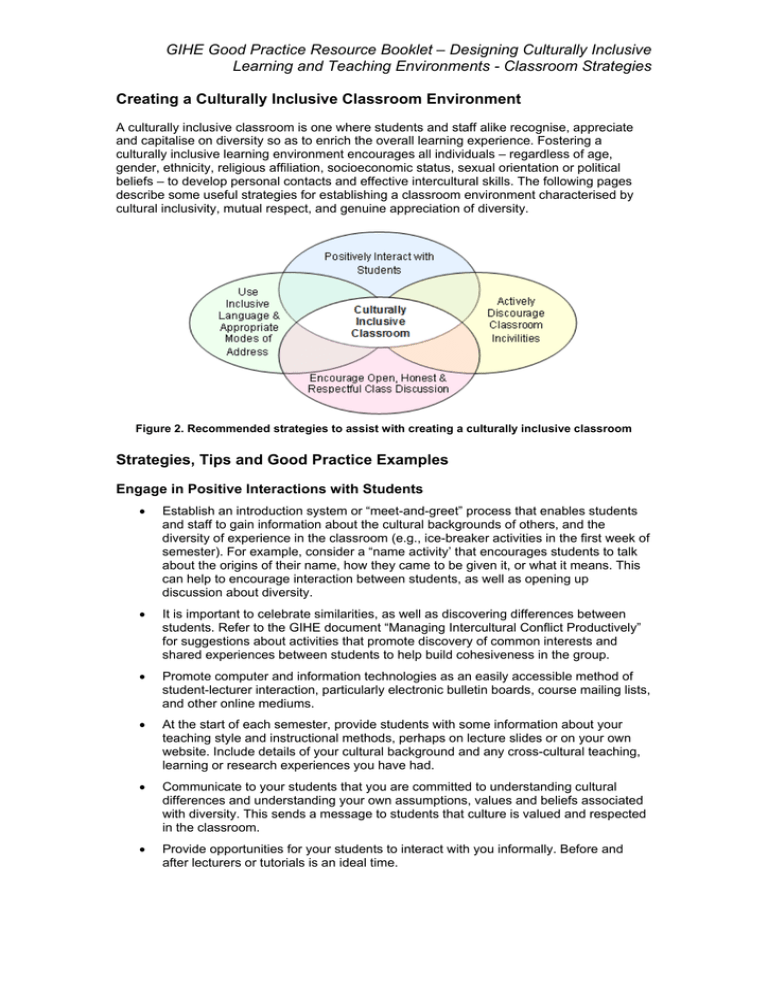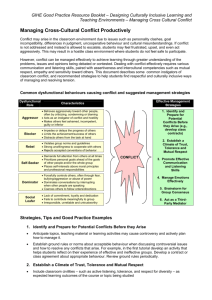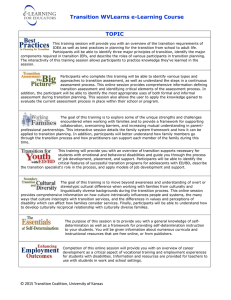Creating a Culturally Inclusive Classroom
advertisement

GIHE Good Practice Resource Booklet – Designing Culturally Inclusive Learning and Teaching Environments - Classroom Strategies Creating a Culturally Inclusive Classroom Environment A culturally inclusive classroom is one where students and staff alike recognise, appreciate and capitalise on diversity so as to enrich the overall learning experience. Fostering a culturally inclusive learning environment encourages all individuals – regardless of age, gender, ethnicity, religious affiliation, socioeconomic status, sexual orientation or political beliefs – to develop personal contacts and effective intercultural skills. The following pages describe some useful strategies for establishing a classroom environment characterised by cultural inclusivity, mutual respect, and genuine appreciation of diversity. Figure 2. Recommended strategies to assist with creating a culturally inclusive classroom Strategies, Tips and Good Practice Examples Engage in Positive Interactions with Students • Establish an introduction system or “meet-and-greet” process that enables students and staff to gain information about the cultural backgrounds of others, and the diversity of experience in the classroom (e.g., ice-breaker activities in the first week of semester). For example, consider a “name activity’ that encourages students to talk about the origins of their name, how they came to be given it, or what it means. This can help to encourage interaction between students, as well as opening up discussion about diversity. • It is important to celebrate similarities, as well as discovering differences between students. Refer to the GIHE document “Managing Intercultural Conflict Productively” for suggestions about activities that promote discovery of common interests and shared experiences between students to help build cohesiveness in the group. • Promote computer and information technologies as an easily accessible method of student-lecturer interaction, particularly electronic bulletin boards, course mailing lists, and other online mediums. • At the start of each semester, provide students with some information about your teaching style and instructional methods, perhaps on lecture slides or on your own website. Include details of your cultural background and any cross-cultural teaching, learning or research experiences you have had. • Communicate to your students that you are committed to understanding cultural differences and understanding your own assumptions, values and beliefs associated with diversity. This sends a message to students that culture is valued and respected in the classroom. • Provide opportunities for your students to interact with you informally. Before and after lecturers or tutorials is an ideal time. GIHE Good Practice Resource Booklet – Designing Culturally Inclusive Learning and Teaching Environments - Classroom Strategies • Make an effort to learn something unique about each student. While this is challenging in large tutorials, exercises such as the “name activity” mentioned earlier can help in this regard. • Display positive nonverbal behaviours (e.g., inviting facial expressions, eye contact, posture, hand gestures, physical distance) to ensure you appear approachable to students. Use Appropriate Modes of Address • During one-on-one interactions, ask what name or form of address students prefer. • During class discussions, refer to students by name as much as possible. • Correct pronunciation of names is very important, as it demonstrates cultural awareness and respect. Remember – if you are in doubt, check with students. • Use inclusive language that avoids ethnocentric tones (e.g., “family name” rather than “last name”, and “given” name rather than “Christian name”) Eliminate Classroom Incivilities • Establish explicit ground-rules for appropriate classroom conduct to protect against cultural exclusion and insensitivity. o Communicate, verbally and non-verbally, high expectations for displaying mutual respect toward all students o Encourage students to negotiate an accepted “code of conduct” and set of disciplinary measures for inappropriate classroom behaviour (refer also to the GIHE document “Managing Intercultural Conflict Productively”). • Respond promptly to any behaviour (verbal or non-verbal) that could be considered prejudiced, biased or discriminatory in nature. Do not tolerate racist, sexists or culturally insensitive comments made by students. Explain Australia’s laws in relation to discrimination and the University’s Student Charter . • Avoid ignoring or neglecting the needs of individual students. For example, ensure you do not have a tendency to favour one group over another when answering questions. • Avoid stereotypes and preconceived assumptions in your teaching practices and course content. • When presenting information on cultural and linguistic diverse individuals or minority groups, clearly cite published literature and research findings, rather than expressing your personal opinion. Similarly, encourage students to draw on diverse data sources/evidence to develop their arguments and critique opinions. Encourage Open and Inclusive Classroom Discussion • Prompt students to ask questions by using open-ended statements, such as “Would anyone like to share a different opinion or perspective?” • Avoid singling out individual students or putting anyone “on the spot”, particularly when discussing culturally or personally sensitive issues. For example, a student will feel pressured if it is assumed they can speak on behalf of all people from their country or culture of origin. • Promote turn-taking when discussing controversial issues. For example, ensure students take turns expressing their own opinions while also listening to (and genuinely considering) the views of others. GIHE Good Practice Resource Booklet – Designing Culturally Inclusive Learning and Teaching Environments - Classroom Strategies • Ask students how they prefer to learn, and, where possible, examine how you might adapt your teaching and learning activities accordingly. For example, inviting students to write a “self-reflective essay” to explain their learning style; completing a learning style inventory assessment, or providing an online forum to openly discuss how they like to learn are ideal methods to explore learning styles. Self-Development Checklist To create a culturally inclusive classroom environment, it is helpful if teaching staff reflect on their own attitudes, assumptions and instructional practices. To what extent do these attitudes, assumptions and practices promote an inclusive learning environment? The following questions can be used as a framework for monitoring your own assumptions, biases, and understandings of cultural diversity in a reflective and potentially productive way. It can also form the basis of a peer-review tool, if required. 10 Questions to Guide Self-Reflection: Creating a Culturally Inclusive Classroom 1. What is my definition of “diversity”? 2. What national, cultural, linguistic or religious group(s) do I belong to? How do my teaching practices reflect this? 3. What do I know about the cultural, linguistic, religious and educational backgrounds of my students and other staff? 4. How could I learn more about the diversity of my students and staff colleagues? 5. What are my perceptions/assumptions of students and staff colleagues from diverse cultural groups? Or with language or dialects different from mine? Or with special needs or requirements? 6. What are the sources of these perceptions (e.g., friends/relatives, media, stereotypes, past experiences)? 7. How do I respond to my students (emotionally, cognitively, and behaviourally), based on these perceptions? 8. What experiences do I have as a result of living, studying or working in culturally and linguistically diverse cultures? How can I capitalise on this experience? 9. How can I adapt my teaching practices to be more responsive to the unique needs of diverse student groups? 10. What other knowledge, skills and resources would help me to teach from a more culturally inclusive perspective? References and Further Resources • Banks, J. A. (1994) Multiethnic Education: Theory and Practice. Needham Heights, MA: Allyn & Bacon. • Bromley, K. D. (1998). Language art: Exploring connections. Needham Heights, MA: Allyn & Bacon • Garcia, E. (1994). Understanding and meeting the challenge of student cultural diversity. Boston: Houghton Mifflin. • Gollnick, D. M., & Chinn, P. C. (2001) Multicultural Education in a Pluralistic Society. New York: Prentice Hall. • Westwood, M. J., Mak, A. S., Barker, M., & Ishiyama, I. (2000). Group procedures and applications for developing sociocultural competencies among immigrants. International Journal for the Advancement of Counselling, 22(4), 317-330. Wlodkowski, R. J., & Ginsberg, M. B. (1995). A framework for culturally responsive teaching, Educational Leadership, 53(1), 17-21. • • Woods, P. R., Barker, M. C., & Daly, A. (2004). Teaching intercultural skills in the multicultural classroom. Paper presented at the 4th Annual International Conference on Business, Honolulu, June 21-24. Excerpt from GIHE Good Practice Resource Booklet on Designing Culturally Inclusive Learning and Teaching Environments prepared by Professor Michelle Barker, Dr Elisha Frederiks and Brona Farrelly Visit www.griffith.edu.au/gihe/internationalisation




